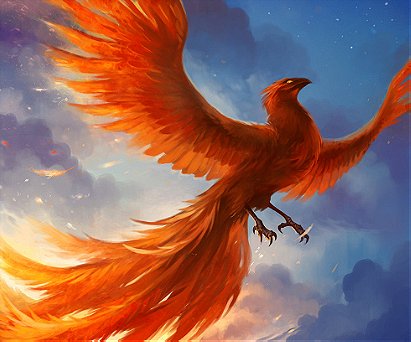Phoenix
In Greek mythology, a phoenix or phenix (Greek: φοῖνιξ phoinix; Latin: phoenix, phœnix, fenix) is a long-lived bird that is cyclically regenerated or reborn. Associated with the sun, a phoenix obtains new life by arising from the ashes of its predecessor. According to some sources, the phoenix dies in a show of flames and combustion, although there are other sources that claim that the legendary bird dies and simply decomposes before being born again. According to some texts, the phoenix could live over 1,400 years before rebirth. Herodotus, Lucan, Pliny the Elder, Pope Clement I, Lactantius, Ovid, and Isidore of Seville are among those who have contributed to the retelling and transmission of the phoenix motif.
In the historical record, the phoenix "could symbolize renewal in general as well as the sun, time, the Empire, metempsychosis, consecration, resurrection, life in the heavenly Paradise, Christ, Mary, virginity, the exceptional man, and certain aspects of Christian life".
The phoenix is sometimes pictured in ancient and medieval literature and medieval art as endowed with a nimbus (halo), which emphasizes the bird's connection with the sun. In the oldest images of phoenixes on record, these nimbi often have seven rays, like Helios (the personified sun of Greek mythology). Pliny the Elder also describes the bird as having a crest of feathers on its head, and Ezekiel the Dramatist compared it to a rooster.
Although the phoenix was generally believed to be colorful and vibrant, there is no clear consensus about its coloration. Tacitus claims that its color made it stand out from all other birds. Some thought that the bird had peacock-like coloring, and Herodotus' claim of red and yellow is popular in many versions of the story on record. Ezekiel the Dramatist declared that the phoenix had red legs and striking yellow eyes, but Lactantius said that its eyes were blue like sapphires and that its legs were covered in scales of yellow-gold with rose-colored talons.
In terms of size, Herodotus, Pliny, Solinus, and Philostratus describe the phoenix as similar in size to an eagle, but Lactantius and Ezekiel the Dramatist both claim that the phoenix was larger, with Lactantius declaring that it was even larger than an ostrich.
Scholars have observed analogues to the phoenix in a variety of cultures. These analogues include:
the Hindu Garuda (गरुड) and Gandaberunda (गण्डभेरुण्ड),
the Russian Firebird (Жар-птица),
the Persian Simorgh (سيمرغ),
the Georgian Paskunji (პასკუნჯი),
the Arabian Anka (عنقاء),
the Turkish Zümrüdü Anka (derived from its Arabian counterpart),
the Tibetan Me Byi karmo,
the Chinese Fenghuang (鳳凰) and Zhu Que (朱雀),
and the Japanese Hō-ō (鳳凰).
In the historical record, the phoenix "could symbolize renewal in general as well as the sun, time, the Empire, metempsychosis, consecration, resurrection, life in the heavenly Paradise, Christ, Mary, virginity, the exceptional man, and certain aspects of Christian life".
The phoenix is sometimes pictured in ancient and medieval literature and medieval art as endowed with a nimbus (halo), which emphasizes the bird's connection with the sun. In the oldest images of phoenixes on record, these nimbi often have seven rays, like Helios (the personified sun of Greek mythology). Pliny the Elder also describes the bird as having a crest of feathers on its head, and Ezekiel the Dramatist compared it to a rooster.
Although the phoenix was generally believed to be colorful and vibrant, there is no clear consensus about its coloration. Tacitus claims that its color made it stand out from all other birds. Some thought that the bird had peacock-like coloring, and Herodotus' claim of red and yellow is popular in many versions of the story on record. Ezekiel the Dramatist declared that the phoenix had red legs and striking yellow eyes, but Lactantius said that its eyes were blue like sapphires and that its legs were covered in scales of yellow-gold with rose-colored talons.
In terms of size, Herodotus, Pliny, Solinus, and Philostratus describe the phoenix as similar in size to an eagle, but Lactantius and Ezekiel the Dramatist both claim that the phoenix was larger, with Lactantius declaring that it was even larger than an ostrich.
Scholars have observed analogues to the phoenix in a variety of cultures. These analogues include:
the Hindu Garuda (गरुड) and Gandaberunda (गण्डभेरुण्ड),
the Russian Firebird (Жар-птица),
the Persian Simorgh (سيمرغ),
the Georgian Paskunji (პასკუნჯი),
the Arabian Anka (عنقاء),
the Turkish Zümrüdü Anka (derived from its Arabian counterpart),
the Tibetan Me Byi karmo,
the Chinese Fenghuang (鳳凰) and Zhu Que (朱雀),
and the Japanese Hō-ō (鳳凰).
Your Rating:
Tags:
My tags:
Update feed
Diabolik added this to a list 5 years, 10 months ago
Favorite Characters (128 characters items)
italia23 rated this 10/10 7 years, 5 months ago
Rylvan posted 2 images 7 years, 8 months ago
 Login
Login









